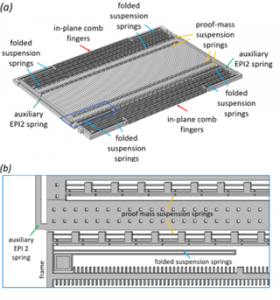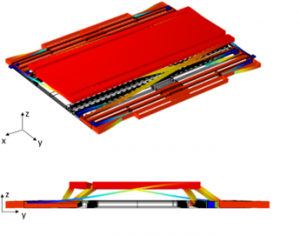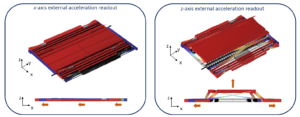Close
Thelma-Double – an innovative MEMS fabrication process
HIGH SENSITIVITY MEMS Z-AXIS ACCELEROMETER WITH IN-PLANE DIFFERENTIAL READOUT
For the first time in a MEMS accelerometer, a motion conversion mechanism is implemented to allow an electrostatic readout based on in-plane comb fingers, thus overcoming the main limitations of out-of-plane parallel plate detection, e.g. nonlinearities, trade-off between sensitivity and full-scale range, pull-in, etc.
The proposed z-axis accelerometer is schematically shown in Fig. 1. It consists in a rectangular proof mass connected through four non-symmetric cross-sectioned springs to two external frames suspended from the substrate through standard rectangular cross-sectioned folded springs. The proof mass, the two auxiliary frames and the folded suspension springs are fabricated such as to have a EPI1+EPI2 out-of-plane thickness. Comb fingers electrodes are located inside the two external frames for the in-plane readout of the z-axis external acceleration. Two additional suspension springs made in EPI2 are finally connected to the proof mass to avoid unwanted spurious torsional modes at low frequencies while not penalizing the desired movement of the structure.

Figure 1. (a) Schematic view of the proposed z-axis accelerometer. (b) Close-up view of the bottom-left corner of the proposed z-axis accelerometer.
The first mode of the structure is computed in COMSOL Multiphysics through a modal analysis and reported in Fig. 2: it consists in a simultaneous translation of the proof mass in the z-direction and of the two external frames in the y-direction.

Figure 2. Modal shape function of the first mode of the structure. The normalized displacement field is shown in color.
The first prototype fabricated by exploiting the features of the Thelma-Double fabrication process by STMicroelectronics shows an experimental sensitivity of 12.9 fF/g which agrees well with numerical predictions computed by considering nominal geometric dimension of the sensor.
[1] V. Zega, G. Gattere, M. Riani, F. Rizzini, A. Frangi ‘High sensitivity MEMS z-axis accelerometer with in-plane differential readout‘ IEEE MEMS 2023, Monaco, Germany, January 15-19, 2023.
[2] G. Gattere, V. Zega, M. Riani, F. Rizzini, F. Maspero, ‘Design and validation of the first z-axis MEMS accelerometer with in-plane readout’ Transducers 2023, Kyoto, Japan, June 25-29, 2023.
A new design strategy for innovative MEMS xz-biaxial accelerometers
Micro-Electro-Mechanical Systems (MEMS) accelerometers are entering high-end applications thanks to their improved performances and low costs. Biaxial sensors able to measure two in-plane components of the external accelations by exploiting a single proof-mass have been recently proposed and optimized both mechanically and electronically in order to minimize cross-axis sensitivity, while preserving a good simmetry between the two axes and high performances. To the authors best knowledge, only very few commercial high-performance xz- or yz- biaxial MEMS accelerometers are available so far.
In this work, we propose an innovative design strategy for xz-biaxial MEMS capacitive accelerometers immune from electrostatic nonlinearities and pull-in instabilities usually related to out-of-plane readout schemes. In particular, thanks to the proposed motion conversion mechanism realizable through the Thelma-Double fabrication process of STMicroelectronics, we achieve a sensitivity bigger than 30fF/g on both axes, a cross-axis sensitivity smaller than 0.04% and a nonlinearity lower than 1% at 50g.

Figure 1. Modal shape function of the first and second modes of the structure. The normalized displacement field is shown in color.
[1] C. Galimberti, G. Gattere, M. Riani, V. Zega ‘A new design strategy for innovative MEMS xz-biaxial accelerometer’ IEEE Sensors Letters 7 (10), (2023) 2503504.
